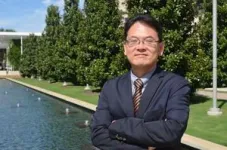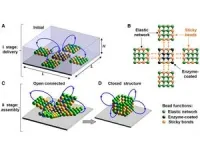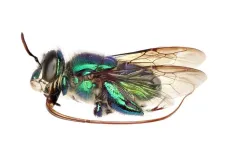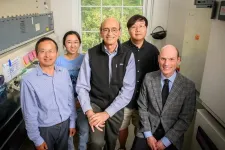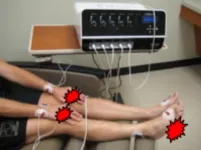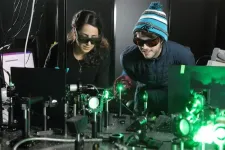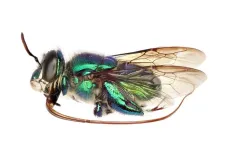(Press-News.org) An article to be published on July 31 in Nature Ecology & Evolution reveals that Luzio, the oldest human skeleton found in São Paulo state (Brazil), was a descendant of the ancestral population that settled the Americas at least 16,000 years ago and gave rise to all present-day Indigenous peoples, such as the Tupi.
Based on the largest set of Brazilian archeological genomic data, the study reported in the article also offers an explanation for the disappearance of the oldest coastal communities, who built the icons of Brazilian archeology known as sambaquis, huge mounds of shells and fishbones used as dwellings, cemeteries and territorial boundaries. Archeologists often refer to these monuments as shell mounds or kitchen middens.
“After the Andean civilizations, the Atlantic coast sambaqui builders were the human phenomenon with the highest demographic density in pre-colonial South America. They were the ‘kings of the coast’ for thousands and thousands of years. They vanished suddenly about 2,000 years ago,” said André Menezes Strauss, an archeologist at the University of São Paulo’s Museum of Archeology and Ethnology (MAE-USP) and principal investigator for the study.
The first author of the article is Tiago Ferraz.The study was supported by FAPESP (projects 17/16451-2 and 20/06527-4) and conducted in partnership with researchers at the University of Tübingen’s Senckenberg Center for Human Evolution and Paleoenvironment (Germany).
The authors analyzed the genomes of 34 samples from four different areas of Brazil’s coast. The fossils were at least 10,000 years old. They came from sambaquis and other parts of eight sites (Cabeçuda, Capelinha, Cubatão, Limão, Jabuticabeira II, Palmeiras Xingu, Pedra do Alexandre and Vau Una).
This material included Luzio, São Paulo’s oldest skeleton, found in the Capelinha river midden in the Ribeira de Iguape valley by a group led by Levy Figuti, a professor at MAE-USP. The morphology of its skull is similar to that of Luzia, the oldest human fossil found to date in South America, dating from about 13,000 years ago. The researchers thought it might have belonged to a biologically different population from present-day Amerindians, who settled in what is now Brazil some 14,000 years ago, but it turns out they were mistaken.
“Genetic analysis showed Luzio to be an Amerindian, like the Tupi, Quechua or Cherokee. That doesn’t mean they’re all the same, but from a global perspective, they all derive from a single migratory wave that arrived in the Americas not more than 16,000 years ago. If there was another population here 30,000 years ago, it didn’t leave descendants among these groups,” Strauss said.
Luzio’s DNA also answered another question. River middens are different from coastal ones, so the find cannot be considered a direct ancestor of the huge classical sambaquis that appeared later. This discovery suggests there were two distinct migrations – into the hinterland and along the coast.
What happened to the sambaqui builders?
Analysis of the genetic material revealed heterogeneous communities with cultural similarities but significant biological differences, especially between coastal communities in the southeast and south.
“Studies of cranial morphology conducted in the 2000s had already pointed to a subtle difference between these communities, and our genetic analysis confirmed it,” Strauss said. “We discovered that one of the reasons was that these coastal populations weren’t isolated but ‘swapped genes’ with inland communities. Over thousands of years, this process must have contributed to the regional differences between sambaquis.”
Regarding the mysterious disappearance of this coastal civilization, comprising the first hunter-gatherers of the Holocene, analysis of the DNA samples clearly showed that, in contrast with the European Neolithic substitution of entire populations, what happened in this part of the world was a change of practices, with a decline in construction of shell middens and the introduction of pottery by sambaqui builders. For example, the genetic material found at Galheta IV (Santa Catarina state), the most emblematic site for the period, has remains not of shells but of ceramics and is similar to the classic sambaquis in this respect.
“This information is compatible with a 2014 study that analyzed pottery shards from sambaquis and found that the pots in question were used to cook not domesticated vegetables but fish. They appropriated technology from the hinterland to process food that was already traditional there,” Strauss said.
About São Paulo Research Foundation (FAPESP)
The São Paulo Research Foundation (FAPESP) is a public institution with the mission of supporting scientific research in all fields of knowledge by awarding scholarships, fellowships and grants to investigators linked with higher education and research institutions in the State of São Paulo, Brazil. FAPESP is aware that the very best research can only be done by working with the best researchers internationally. Therefore, it has established partnerships with funding agencies, higher education, private companies, and research organizations in other countries known for the quality of their research and has been encouraging scientists funded by its grants to further develop their international collaboration. You can learn more about FAPESP at www.fapesp.br/en and visit FAPESP news agency at www.agencia.fapesp.br/en to keep updated with the latest scientific breakthroughs FAPESP helps achieve through its many programs, awards and research centers. You may also subscribe to FAPESP news agency at http://agencia.fapesp.br/subscribe.
END
Luzio, who lived in São Paulo 10,000 years ago, was Amerindian like Indigenous people now, DNA reveals
An investigation covering four different parts of Brazil carried out analysis of genomic data from 34 fossils, including larger skeletons and the famous mounds of shells and fishbones built on the coast, and revealed differences between communities
2023-07-31
ELSE PRESS RELEASES FROM THIS DATE:
Bees evolved from ancient supercontinent, diversified faster than suspected
2023-07-31
The first bees evolved on an ancient supercontinent more than 120 million years ago, diversifying faster and spreading wider than previously suspected, a new study shows.
Led by Washington State University researchers, the study provides a new best estimate for when and where bees first evolved. Newly published in the journal Current Biology, the project reconstructed the evolutionary history of bees, estimated their antiquity, and identified their likely geographical expansion around the world.
The results indicate their point of origin was in western Gondwana, an ancient supercontinent that at that time included today's continents of Africa and South America.
“There’s ...
New algorithm ensnares its first ‘potentially hazardous’ asteroid
2023-07-31
Link to Google Drive folder containing images, videos and caption/credit information:
https://drive.google.com/drive/folders/19LP7UZbVKkTXSFds6DaKSy1lp014Hw4z?usp=sharing
Link to release:
https://www.washington.edu/news/2023/07/31/heliolinc3d/
FROM: James Urton
University of Washington
+1 206-543-2580
jurton@uw.edu
Ranpal Gill
Vera C. Rubin Observatory
+1 520-309-6195
rgill@lsst.org
Note: Researcher contact information at the end
For ...
Fascination of Science: 60 Encounters with Pioneering Researchers of Our Time
2023-07-31
What makes a brilliant scientist? Who are the people behind the greatest discoveries of our time? Connecting art and science, photographer Herlinde Koelbl seeks the answers in this English translation of the German book Fascination of Science, an indelible collection of portraits of and interviews with sixty pioneering scientists of the twenty-first century. Koelbl's approach is intimate and accessible, and her highly personal interviews with her subjects reveal the forces (as well as the personal quirks) that motivate the scientists' work; for example, one wakes up at 3 am because ...
Team identifies key driver of cancer cell death pathway that activates immune cells
2023-07-31
CHAMPAIGN, Ill. — Scientists have identified a protein that plays a pivotal role in the action of several emerging cancer therapies. The researchers say the discovery will likely aid efforts to fine-tune the use of immunotherapies against several challenging cancers. They report their findings in the journal Cancer Research.
“Most anticancer drugs cause cancer cells to shrivel up and die in a controlled process known as apoptosis. But apoptosis does not usually strongly activate immune cells,” said David Shapiro, a professor ...
Scrambler therapy may offer lasting relief for chronic pain, review paper suggests
2023-07-31
FOR IMMEDIATE RELEASE
A new review paper co-authored by two Johns Hopkins pain experts suggests that scrambler therapy, a noninvasive pain treatment, can yield significant relief for approximately 80%–90% of patients with chronic pain, and it may be more effective than another noninvasive therapy: transcutaneous electrical nerve stimulation (TENS). The write-up was published online July 13 in The New England Journal of Medicine.
Scrambler therapy, approved by the U.S. Food and Drug Administration in 2009, administers electrical stimulation through the skin via electrodes placed in areas of the body above and below where chronic pain is felt. The goal is to capture the nerve endings ...
Icahn School of Medicine at Mount Sinai receives $11.5 million grant renewal to study the impact of psychosocial stress on cardiovascular disease
2023-07-31
New York, NY (July 31, 2023)—Psychosocial stress profoundly affects people’s lives globally, not least because it can be a critical risk factor for cardiovascular disease. Thanks to an $11.5 million award renewal from the National Heart, Lung, and Blood Institute (NHLBI) of the National Institutes of Health, distinguished researchers at the Icahn School of Medicine at Mount Sinai and elsewhere aim to gain a deeper understanding of how stress influences cardiovascular health.
“To address residual cardiovascular risk in patients, our research program aims to bolster our mechanistic understanding ...
Way cool: UVA professor developing ‘freeze ray’ technology for the Air Force
2023-07-31
You know that freeze-ray gun that “Batman” villain Mr. Freeze uses to “ice” his enemies? A University of Virginia professor thinks he may have figured out how to make one in real life.
The discovery – which, unexpectedly, relies on heat-generating plasma – is not meant for weaponry, however. Mechanical and aerospace engineering professor Patrick Hopkins wants to create on-demand surface cooling for electronics inside spacecraft and high-altitude jets.
“That’s the primary problem right now,” Hopkins said. “A lot of electronics on board heat up, but they have no way to cool down.”
The U.S. Air Force likes the prospect of a freeze ...
Bees likely evolved from ancient supercontinent, earlier than suspected
2023-07-31
PULLMAN, Wash. –The origin of bees is tens of millions of years older than most previous estimates, a new study shows.
A team led by Washington State University researchers traced the bee genealogy back more than 120 million years to an ancient supercontinent, Gondwana, which included today’s continents of Africa and South America.
In a study that proposes a new evolutionary history of bees, the researchers found evidence that bees originated earlier, diversified faster and spread wider than many scientists previously suspected. They published their findings in the journal Current ...
Routinely drinking alcohol may raise blood pressure even in adults without hypertension
2023-07-31
Research Highlights:
An analysis of data from seven studies involving more than 19,000 adults in the United States, Korea and Japan found a clear association between increases in systolic (top-number) blood pressure and the number of alcoholic beverages consumed daily.
Even people who drank one alcoholic beverage per day showed a link to higher blood pressure when compared to non-drinkers, reinforcing the American Heart Association’s advice to limit alcohol intake and to not start drinking alcohol if you do not already.
Embargoed until ...
This disease can be caused by a food allergy and prevent children from eating. A new study may show how to treat it
2023-07-31
A new study from Tulane University has identified a new treatment for a chronic immune system disease that can prevent children from eating.
Eosinophilic esophagitis (EoE) is triggered by food allergies or airborne allergens which causes a type of white blood cell, eosinophils, to build up in the lining of the esophagus. This causes the esophagus to shorten and the esophageal wall to thicken, making swallowing difficult and causing food to get stuck in the throat.
The disease occurs in an estimated 1 in 2,000 adults but more frequently affects children (1 in 1,500) where symptoms can be harder to diagnose and pose greater risks as difficulty feeding can lead to malnutrition, weight loss and ...
LAST 30 PRESS RELEASES:
Researchers highlight role of alternative RNA splicing in schizophrenia
NTU Singapore scientists find new way to disarm antibiotic-resistant bacteria and restore healing in chronic wounds
Research suggests nationwide racial bias in media reporting on gun violence
Revealing the cell’s nanocourier at work
Health impacts of nursing home staffing
Public views about opioid overdose and people with opioid use disorder
Age-related changes in sperm DNA may play a role in autism risk
Ambitious model fails to explain near-death experiences, experts say
Multifaceted effects of inward foreign direct investment on new venture creation
Exploring mutations that spontaneously switch on a key brain cell receptor
Two-step genome editing enables the creation of full-length humanized mouse models
Pusan National University researchers develop light-activated tissue adhesive patch for rapid, watertight neurosurgical sealing
Study finds so-called super agers tend to have at least two key genetic advantages
Brain stimulation device cleared for ADHD in the US is overall safe but ineffective
Scientists discover natural ‘brake’ that could stop harmful inflammation
Tougher solid electrolyte advances long-sought lithium metal batteries
Experts provide policy roadmap to reduce dementia risk
New 3D imaging system could address limitations of MRI, CT and ultrasound
First-in-human drug trial lowers high blood fats
Decades of dredging are pushing the Dutch Western Scheldt Estuary beyond its ecological limits
A view into the innermost workings of life: First scanning electron microscope with nanomanipulator inaugurated in hesse at Goethe University
Simple method can enable early detection and prevention of chronic kidney disease
S-species-stimulated deep reconstruction of ultra-homogeneous CuS nanosheets for efficient HMF electrooxidation
Mechanical and corrosion behavior of additively manufactured NiTi shape memory alloys
New discovery rewrites the rules of antigen presentation
Researchers achieve chain-length control of fatty acid biosynthesis in yeast
Water interactions in molecular sieve catalysis: Framework evolution and reaction modulation
Shark biology breakthrough: Study tracks tiger sharks to Maui mating hub
Mysterious iron ‘bar’ discovered in famous nebula
World-first tool reduces harmful engagement with AI-generated explicit images
[Press-News.org] Luzio, who lived in São Paulo 10,000 years ago, was Amerindian like Indigenous people now, DNA revealsAn investigation covering four different parts of Brazil carried out analysis of genomic data from 34 fossils, including larger skeletons and the famous mounds of shells and fishbones built on the coast, and revealed differences between communities

